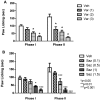The antinociceptive effects of nicotinic partial agonists varenicline and sazetidine-A in murine acute and tonic pain models
- PMID: 22678099
- PMCID: PMC3422531
- DOI: 10.1124/jpet.112.194506
The antinociceptive effects of nicotinic partial agonists varenicline and sazetidine-A in murine acute and tonic pain models
Abstract
Nicotinic agonists display a wide-range profile of antinociceptive activity in acute, tonic, and chronic pain models. However, their effectiveness is limited by their unacceptable side effects. We investigated the antinociceptive effects of two new α4β2* nicotinic partial agonists, varenicline and sazetidine-A, in acute thermal and tonic pain mouse models. Both drugs failed to induce significant effects in the tail-flick and hot-plate tests after subcutaneous administration. However, they blocked nicotine's effects in these tests at very low doses. In contrast to acute pain tests, varenicline and sazetidine-A dose-dependently induced an analgesic effect in the mouse formalin test after systemic administration. Their antinociceptive effects were mediated, however, by different nicotinic acetylcholine receptor (nAChR) subtypes. Sazetidine-A effects were mediated by β2* nAChR subtypes, whereas varenicline actions were attributed to α3β4 nAChRs. Moreover, low inactive doses of varenicline blocked nicotine's actions in phase II of the formalin test. Overall, our results suggest that the antagonistic actions of varenicline at low doses are mediated by β2*-nAChRs and at higher doses as an agonist by α3β4*-nAChRs. In contrast, both actions of sazetidine-A are mediated by β2*-nAChR subtypes. These results suggest that nicotinic partial agonists possess analgesic effects in a rodent tonic pain model and may provide a potential treatment for the treatment of chronic pain disorders.
Figures







Similar articles
-
Dissociation between duration of action in the forced swim test in mice and nicotinic acetylcholine receptor occupancy with sazetidine, varenicline, and 5-I-A85380.Psychopharmacology (Berl). 2011 Sep;217(2):199-210. doi: 10.1007/s00213-011-2271-y. Epub 2011 Apr 13. Psychopharmacology (Berl). 2011. PMID: 21487659 Free PMC article.
-
Analgesic effects of Sazetidine-A, a new nicotinic cholinergic drug.Anesthesiology. 2008 Sep;109(3):512-9. doi: 10.1097/ALN.0b013e3181834490. Anesthesiology. 2008. PMID: 18719450
-
Chronic sazetidine-A maintains anxiolytic effects and slower weight gain following chronic nicotine without maintaining increased density of nicotinic receptors in rodent brain.J Neurochem. 2014 May;129(4):721-31. doi: 10.1111/jnc.12653. Epub 2014 Feb 7. J Neurochem. 2014. PMID: 24422997 Free PMC article.
-
The contribution of agonist and antagonist activities of α4β2* nAChR ligands to smoking cessation efficacy: a quantitative analysis of literature data.Psychopharmacology (Berl). 2018 Sep;235(9):2479-2505. doi: 10.1007/s00213-018-4921-9. Epub 2018 Jul 7. Psychopharmacology (Berl). 2018. PMID: 29980822 Review.
-
The role of neuronal nicotinic acetylcholine receptors in antinociception: effects of ABT-594.J Physiol Paris. 1998 Jun-Aug;92(3-4):221-4. doi: 10.1016/s0928-4257(98)80014-4. J Physiol Paris. 1998. PMID: 9789812 Review.
Cited by
-
Altered nocifensive behavior in animal models of autism spectrum disorder: The role of the nicotinic cholinergic system.Neuropharmacology. 2016 Dec;111:323-334. doi: 10.1016/j.neuropharm.2016.09.013. Epub 2016 Sep 13. Neuropharmacology. 2016. PMID: 27638450 Free PMC article.
-
Chemistry and pharmacological studies of 3-alkoxy-2,5-disubstituted-pyridinyl compounds as novel selective α4β2 nicotinic acetylcholine receptor ligands that reduce alcohol intake in rats.J Med Chem. 2013 Apr 11;56(7):3000-11. doi: 10.1021/jm4000374. Epub 2013 Apr 1. J Med Chem. 2013. PMID: 23540678 Free PMC article.
-
Sazetidine-A Activates and Desensitizes Native α7 Nicotinic Acetylcholine Receptors.Neurochem Res. 2015 Oct;40(10):2047-54. doi: 10.1007/s11064-014-1302-6. Epub 2014 Apr 12. Neurochem Res. 2015. PMID: 24728867 Free PMC article.
-
Targeting glutamate homeostasis for potential treatment of nicotine dependence.Brain Res Bull. 2016 Mar;121:1-8. doi: 10.1016/j.brainresbull.2015.11.010. Epub 2015 Nov 14. Brain Res Bull. 2016. PMID: 26589642 Free PMC article. Review.
-
Augmenting the antinociceptive effects of nicotinic acetylcholine receptor activity through lynx1 modulation.PLoS One. 2018 Jul 3;13(7):e0199643. doi: 10.1371/journal.pone.0199643. eCollection 2018. PLoS One. 2018. PMID: 29969495 Free PMC article.
References
-
- Abbott FV, Franklin KB, Westbrook RF. (1995) The formalin test: scoring properties of the first and second phases of the pain response in rats. Pain 60:91–102 - PubMed
-
- Aceto MD, Bagley RS, Dewey WL, Fu TC, Martin BR. (1986) The spinal cord as a major site for the antinociceptive action of nicotine in the rat. Neuropharmacology 25:1031–1036 - PubMed
-
- Bitner RS, Nikkel AL, Curzon P, Arneric SP, Bannon AW, Decker MW. (1998) Role of the nucleus raphe magnus in antinociception produced by ABT-594: immediate early gene responses possibly linked to neuronal nicotinic acetylcholine receptors on serotonergic neurons. J Neurosci 18:5426–5432 - PMC - PubMed
-
- Christensen MK, Smith DF. (1990) Antinociceptive effects of the stereoisomers of nicotine given intrathecally in spinal rats. J Neural Transm Gen Sect 80:189–194 - PubMed
Publication types
MeSH terms
Substances
Grants and funding
LinkOut - more resources
Full Text Sources
Medical

